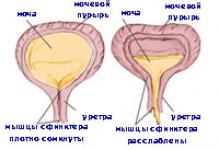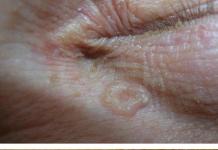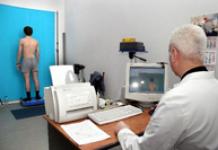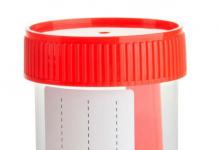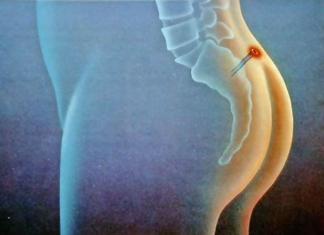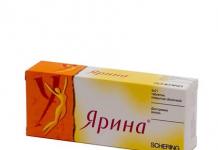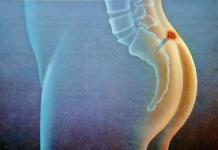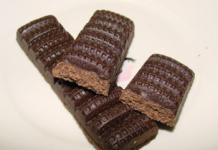Result: positive feedback
Helps during PMS
Advantages: Eliminates swelling, the effect of one tablet is enough for the whole day, I did not notice any side effects, affordable
Disadvantages: Can't drink for a long time
Every month during PMS I suffer from swelling. Now it’s summer, it’s extremely difficult for my heart, so now in the morning I resemble a bloated balloon. Everything swells - arms, legs, and, worst of all, the face. After my complaints, the therapist prescribed Hypothiazide. I had never taken diuretics before; first of all, I read the side effects and was scared, because there was everything from arrhythmia to confusion. The doctor said that the main thing here is not to drink the medicine for a long time, then there will be no problems. And I don’t need to take Hypothiazide for a long time. PMS usually lasts only 7-9 days for me, which is probably why during treatment with it my condition changed exclusively for the better. The drug relieved me of swelling on the first day, and not to some extent, but completely. Even my legs, which tended to swell the most, became light as feathers, and my face turned completely normal. By the way, due to my absent-mindedness, I took the pill only at night, then I was afraid that now I would have to run to the toilet all night. Oddly enough, I only had to get up once, and despite this, I woke up in the morning without any swelling at all. The effect lasted all day and the swelling returned only in the evening, and then only the legs swollen and to a slight extent. The instructions say that the effect of the drug can last even for a couple of days. I didn’t really have such a phenomenal effect, but one tablet had enough strength for me to walk without swelling all day. I personally think that this is also a more than worthy effect. I think that I will continue to use the drug in the future, since it is quite inexpensive, its effect is impressive, and, as it turns out, it has no terrible side effects.
Result: negative feedback
Harmless and practically useless
Advantages: Harmless, inexpensive
Disadvantages: Ineffective
I drank it together with Valz, who manages to lower my blood pressure to a maximum of 140/120 and hoped that with the help of Hypothiazide I would be able to bring the level to normal. Unfortunately, it didn’t work out, because the drug turned out to be extremely weak in effect. After taking it, I did not feel either a strong diuretic effect or a more or less decent decrease in blood pressure. I measured it an hour later, five hours later, in the evening, no striking differences - the tanometer showed 130/110. Purely out of curiosity, I decided to drink the product for a couple more days, counting on the possibility that the effect would increase over time, but this did not happen either. The pressure remained as high as before, and there was no point in taking any further risks. I can only mention two positive points in this whole story. Hypothiazide turned out to be as harmless as it was ineffective and it was very inexpensive, so I did not suffer any significant losses while taking it
Result: negative feedback
Doesn't work at all as expected
Advantages: Except the price
Disadvantages: Begins to act only after 4-5 hours, causes severe thirst, too strong and long-lasting diuretic effect, causes pain in the kidneys and dizziness
It's not that it's ineffective, it just doesn't work the way we would like. The drug has a delayed effect, if after other diuretics you start running to the toilet after an hour and a half, then in the case of Hypothiazide this happens after 4-5 hours. I couldn’t know this, so I took half a tablet during the day so that the diuretic effect of the drug would end by the time I went to bed. But in fact it turned out that the liquid began to come out just closer to night, and it happened very violently. The reason is not only the strength of Hypothiazide, but also the side effect. The drug made me very thirsty, which made me constantly thirsty. It turned out to be a vicious circle - because side effect I constantly drank the medication, and because of the diuretic effect itself, I constantly went to the toilet. Dry mouth stopped tormenting me only when the effect of Hypothiazide weakened, and this happened around dawn. Of course, after this, my swelling disappeared, but there was little joy from this, because by that moment I felt simply disgusting. My head ached and felt dizzy, I felt very nauseous, my stomach and kidneys hurt, I was incredibly weak. Because of this, I couldn’t go to work that day, I had to lie on the bed and wait for me to feel better.
Result: positive feedback
Good for patients with CHF
Advantages: Cheap, good effect, long-lasting effect, does not harm health if the dose is correctly selected
Cons: Hard to find on sale
For heart patients like me, who suffer from edema every day and all day long, this is almost ideal. Hypothiazide has a very high quality, strong and long-lasting effect. After drinking one tablet, the swelling disappeared, and its effect lasts for almost a couple of days. Because of this, I take the medicine only once every 2 days in order to feel good and look decent (I myself have swelling on my face). Also because of this long-lasting effect, Hypothiazide is very economical. It’s already inexpensive, but here it turns out to be doubly profitable - a package worth 110 rubles lasts me almost a month and a half. If you choose the right dose, you can even do without side effects. At first, for some reason, the doctor prescribed me to take 2 tablets at once, and for me this dose turned out to be too high. Immediately I began to feel dizzy, my muscles began to ache, my heart began to beat unevenly. I took it and reduced my dose to one tablet, and since then I haven’t suffered from anything except thirst.
Of course, the indications do not say anything about taking the product for weight loss, but I used it for this very purpose. I bought a prom dress in advance, in the spring, but in the summer I simply couldn’t fit into it. It was too late to lose weight, I decided to get rid of the water for now in order to fit into the treasured bra. What can I say, Hypothiazide is simply amazing in this regard. With its help, I lost 2.5 kg in one day, and the zipper immediately closed without difficulty. To be honest, I was a little afraid at first, I thought that I would feel very bad after such violence against the body, but the drug turned out to be quite mild. It didn’t cause a sharp and strong desire to urgently run to the toilet, so I didn’t have to look for the treasured stall in all sorts of inconvenient places. I just went there a little more often than usual, the liquid came out gradually, and apparently because of this I didn’t have any bad experiences. side effects like dizziness and weakness. Only my mouth was a little dry, but the next day that went away, so I can call Hypothiazide a fairly safe remedy. Just do not forget that it is strictly forbidden to resort to such an extreme method of losing weight often, because diuretics, along with liquid, wash calcium out of the body. And so, for a one-time occasion the best remedy and you can't imagine it.
Diuretic
Drug: HYPOTHIAZIDE®
Active substance of the drug:
hydrochlorothiazide
ATX code: C03AA03
CFG: Diuretic
Registration number: P No. 013510/01
Registration date: 11/21/07
Owner reg. credential: CHINOIN Pharmaceutical and Chemical Works Private Co. Ltd. (Hungary)
Hypothiazide release form, drug packaging and composition.
The tablets are white or almost white, round, flat, with an “H” engraving on one side and a scored line on the other. 1 tab. hydrochlorothiazide 25 mg - «- 100 mg
Excipients: magnesium stearate, talc, gelatin, corn starch, lactose monohydrate.
20 pcs. - blisters (1) - cardboard packs.
The description of the drug is based on the officially approved instructions for use.
Pharmacological action Hypothiazide
Diuretic.
The primary mechanism of action of thiazide diuretics is to increase diuresis by blocking the reabsorption of sodium and chloride ions at the beginning of the renal tubules. As a result, the excretion of sodium and chlorine and, consequently, water increases. The excretion of potassium and magnesium also increases.
At maximum therapeutic doses, the diuretic/natriuretic effect of all thiazides is approximately the same. Natriuresis and diuresis occur within 2 hours and reach their maximum after about 4 hours. They also reduce carbonic anhydrase activity by increasing the excretion of bicarbonate ion, but this effect is usually mild and does not affect urine pH.
Hydrochlorothiazide also has antihypertensive properties. Thiazide diuretics have no effect on normal blood pressure.
Pharmacokinetics of the drug.
Suction and distribution
Hydrochlorothiazide is incompletely, but rather quickly absorbed from the gastrointestinal tract. This effect lasts for 6-12 hours. After oral administration of a dose of 100 mg, Cmax in the blood plasma is achieved after 1.5-2.5 hours. At the maximum of diuretic activity (approximately 4 hours after administration), the concentration of hydrochlorothiazide in the blood plasma is 2 mcg/ml .
Plasma protein binding is 40%.
Removal
The primary route of elimination is by the kidneys (filtration and secretion) in unchanged form. T1/2 for patients with normal renal function is 6.4 hours. T1/2 for patients with moderate renal failure is 11.5 hours T1/2 for patients with CC<30 мл/мин составляет 20.7 ч. Гидрохлоротиазид проникает через плацентарный барьер и выделяется с грудным молоком.
Indications for use:
Arterial hypertension (as monotherapy, as part of complex antihypertensive therapy);
- edematous syndrome of various origins (including chronic heart failure, nephrotic syndrome, premenstrual tension syndrome, acute glomerulonephritis, chronic renal failure, portal hypertension, treatment with corticosteroids);
- control of polyuria, mainly in nephrogenic diabetes insipidus;
- prevention of stone formation in the urinary tract in predisposed patients (reduction of hypercalciuria).
Dosage and method of administration of the drug.
The dose should be selected individually. With constant medical supervision, the minimum effective dose is established. The drug should be taken orally after meals.
For adults
For arterial hypertension, the initial dose is 25-50 mg/day once, as monotherapy or in combination with other antihypertensive drugs. For some patients, an initial dose of 12.5 mg is sufficient (either as monotherapy or in combination). It is necessary to use the minimum effective dose, not exceeding 100 mg/day. When combining hypothiazide with other antihypertensive drugs, it may be necessary to reduce the dose of the other drug to prevent an excessive decrease in blood pressure.
The hypotensive effect appears within 3-4 days, but it may take 3-4 weeks to achieve optimal effect. After completion of therapy, the hypotensive effect persists for 1 week.
For edematous syndrome of various origins, the initial dose is 25-100 mg/day once or once every 2 days. Depending on the clinical response, the dose can be reduced to 25-50 mg/day once or once every 2 days. In some severe cases, at the beginning of treatment, it may be necessary to increase the dose of the drug to 200 mg/day.
For premenstrual tension syndrome, the drug is prescribed at a dose of 25 mg/day and is used from the onset of symptoms until the onset of menstruation.
For nephrogenic diabetes insipidus, the usual daily dose of the drug is 50-150 mg (in several doses).
Due to increased loss of potassium and magnesium ions during treatment (serum potassium levels may be<3.0 ммоль/л) возникает необходимость в замещении калия и магния.
For children
Doses should be set based on the child’s body weight. Usual pediatric daily doses: 1-2 mg/kg body weight or 30-60 mg/m2 body surface area 1 time/day. The daily dose for children aged 3 to 12 years is 37.5-100 mg.
Side effects of Hypothiazide:
From the central nervous system and peripheral nervous system: dizziness, temporarily blurred vision, headache, paresthesia.
From the digestive system: cholecystitis, pancreatitis, cholestatic jaundice, diarrhea, sialadenitis, constipation, anorexia.
From the cardiovascular system: arrhythmia, orthostatic hypotension, vasculitis.
From the urinary system: impaired renal function, interstitial nephritis.
From the hematopoietic system: very rarely - leukopenia, agranulocytosis, thrombocytopenia, hemolytic anemia, aplastic anemia.
From the metabolic side: hyperglycemia (a decrease in glucose tolerance can provoke the manifestation of previously latent diabetes mellitus), glucosuria, hyperuricemia (with the development of an attack of gout), hypokalemia, hypomagnesemia, hypercalcemia, hyponatremia (including confusion, convulsions, lethargy, slow thinking, fatigue, excitability, muscle cramps), hypochloremic alkalosis (including dry mouth, thirst, irregular heart rhythm, changes in mood or psyche, muscle cramps and pain, nausea, vomiting, unusual fatigue or weakness) . Hypochloremic alkalosis can cause hepatic encephalopathy or hepatic coma. When using the drug in high doses, an increase in serum lipid levels is possible.
Allergic reactions: urticaria, purpura, necrotizing vasculitis, Stevens-Johnson syndrome, respiratory distress syndrome (including pneumonitis, non-cardiogenic pulmonary edema), photosensitivity, anaphylactic reactions up to shock.
Other: decreased potency.
Contraindications to the drug:
Anuria;
- severe renal failure (CK<30 мл/мин);
- severe liver failure;
- difficult to control diabetes mellitus;
- Addison's disease;
- refractory hypokalemia, hyponatremia, hypercalcemia;
- children under 3 years of age (for solid dosage form);
- hypersensitivity to the components of the drug;
- hypersensitivity to sulfonamide derivatives.
The drug should be used with caution in case of hypokalemia, hyponatremia, hypercalcemia, coronary artery disease, liver cirrhosis, gout, lactose intolerance, use of cardiac glycosides, as well as in elderly patients.
Use during pregnancy and lactation.
The use of the drug is contraindicated in the first trimester of pregnancy. In the second and third trimesters of pregnancy, the use of the drug is possible only if the expected benefit to the mother outweighs the potential risk to the fetus.
Hydrochlorothiazide penetrates the placental barrier. There is a risk of fetal or neonatal jaundice, thrombocytopenia and other consequences.
The drug is excreted in breast milk. If it is necessary to use the drug during lactation, the issue of stopping breastfeeding should be decided.
Special instructions for the use of Hypothiazide.
During long-term course of treatment, clinical symptoms of water-electrolyte imbalance should be carefully monitored, primarily in high-risk patients: patients with diseases of the cardiovascular system, liver dysfunction, severe vomiting or signs of water-electrolyte imbalance (in including dry mouth, thirst, weakness, lethargy, drowsiness, anxiety, muscle pain or cramps, muscle weakness, hypotension, oliguria, tachycardia, gastrointestinal complaints).
The use of potassium-containing drugs or foods rich in potassium (including fruits, vegetables), especially when potassium is lost due to increased diuresis, prolonged diuretic therapy, or concomitant treatment with digitalis glycosides or corticosteroid drugs, helps avoid hypokalemia.
Increased magnesium excretion in urine when using thiazides can lead to hypomagnesemia.
With reduced renal function, monitoring of creatinine clearance is necessary. In patients with impaired renal function, the drug may cause azotemia and the development of cumulative effects. If renal dysfunction is obvious, discontinuation of the drug should be considered when oliguria occurs.
In patients with impaired liver function or progressive liver disease, thiazides should be used with caution, since slight changes in fluid and electrolyte balance, as well as serum ammonium levels, can cause hepatic coma.
In severe cerebral and coronary sclerosis, the use of the drug requires special caution.
Treatment with thiazide drugs may impair glucose tolerance. During a long course of treatment for manifest and latent diabetes mellitus, systematic monitoring of carbohydrate metabolism is necessary due to the potential need to change the dose of hypoglycemic drugs.
Enhanced monitoring of the condition of patients with impaired uric acid metabolism is required.
Alcohol, barbiturates, and opioid analgesics enhance the orthostatic hypotensive effect of thiazide diuretics.
In rare cases, during long-term therapy, pathological changes in the parathyroid glands were observed, accompanied by hypercalcemia and hypophosphatemia.
Thiazides can reduce the amount of iodine bound to serum proteins without causing signs of thyroid dysfunction.
The possibility of gastrointestinal complaints in patients with lactose intolerance should be taken into account, since Hypothiazide 25 mg tablets contain 63 mg of lactose, Hypothiazide 100 mg - 39 mg of lactose.
Impact on the ability to drive vehicles and operate machinery
In the initial stage of using the drug (the duration of this period is determined individually), it is forbidden to drive a car or perform work that requires increased attention.
Drug overdose:
Symptoms: due to the loss of fluid and electrolytes with an overdose of the drug, tachycardia, decreased blood pressure, shock, weakness, confusion, dizziness, spasms of the calf muscles, paresthesia, impaired consciousness, fatigue, nausea, vomiting, thirst, polyuria, oliguria or anuria may be observed. (due to hemoconcentration), hypokalemia, hyponatremia, hypochloremia, alkalosis, increased levels of urea nitrogen in the blood (especially in patients with renal failure).
Treatment: artificial vomiting, gastric lavage, use of activated carbon. If blood pressure decreases or a state of shock occurs, blood volume and electrolytes (including potassium, sodium) should be replaced. Water and electrolyte balance (especially serum potassium levels) and renal function should be monitored until normal values are established. There is no specific antidote.
Interaction of Hypothiazide with other drugs.
The simultaneous use of hypothiazide with lithium salts should be avoided, since the renal clearance of lithium decreases and its toxicity increases.
With the simultaneous use of Hypothiazide with antihypertensive drugs, their effect is potentiated and there may be a need for dose adjustment.
With simultaneous use of Hypothiazide with cardiac glycosides, hypokalemia and hypomagnesemia associated with the action of thiazide diuretics may increase the toxicity of digitalis.
With simultaneous use of hypothiazide with amiodarone, the risk of arrhythmias associated with hypokalemia increases.
With the simultaneous use of Hypothiazide with oral hypoglycemic agents, the effectiveness of the latter decreases and hyperglycemia may develop.
With simultaneous use of Hypothiazide with corticosteroid drugs and calcitonin, the degree of potassium excretion increases.
With simultaneous use of Hypothiazide with NSAIDs, the diuretic and hypotensive effects of thiazides are weakened.
With simultaneous use of Hypothiazide with non-depolarizing muscle relaxants, the effect of the latter is enhanced.
With the simultaneous use of hypothiazide with amantadine, the concentration and toxicity of the latter increases, resulting in a decrease in its clearance.
With the simultaneous use of hypothiazide with cholestyramine, the absorption of hydrochlorothiazide decreases.
With simultaneous use of Hypothiazide with ethanol, barbiturates and narcotic analgesics, the risk of developing orthostatic hypotension increases.
Thiazides can reduce plasma protein-bound iodine levels; increase the concentration of bilirubin in the blood serum.
Before testing for parathyroid function, thiazides should be discontinued.
Terms of sale in pharmacies.
The drug is available with a prescription.
Terms of storage conditions for the drug Hypothiazide.
The drug should be stored out of the reach of children, protected from light at a temperature of 15° to 25°C. Shelf life – 5 years.
1 tablet contains hydrochlorothiazide 25 mg
pharmachologic effect
Diuretic.
At maximum therapeutic doses, the diuretic/natriuretic effect of all thiazides is approximately the same. Natriuresis and diuresis occur within 2 hours and reach their maximum after about 4 hours. They also reduce carbonic anhydrase activity by increasing the excretion of bicarbonate ion, but this effect is usually mild and does not affect urine pH.
Hydrochlorothiazide also has antihypertensive properties. Thiazide diuretics have no effect on normal blood pressure.
Indications
- arterial hypertension (in the form of monotherapy, as part of complex antihypertensive therapy);
- edema syndrome of various origins (including chronic heart failure, nephrotic syndrome, premenstrual tension syndrome, acute glomerulonephritis, chronic renal failure, portal hypertension, treatment with corticosteroids);
- control of polyuria, mainly in nephrogenic diabetes insipidus;
- prevention of stone formation in the urinary tract in predisposed patients (reduction of hypercalciuria).
Directions for use and doses
The dose should be selected individually. With constant medical supervision, the minimum effective dose is established. The drug should be taken orally after meals.
For adults
At arterial hypertension The initial dose is 25-50 mg/day once, as monotherapy or in combination with other antihypertensive drugs. For some patients, an initial dose of 12.5 mg is sufficient (either as monotherapy or in combination). It is necessary to use the minimum effective dose, not exceeding 100 mg/day. When combined Hypothiazide with other antihypertensive drugs, it may be necessary to reduce the dose of the other drug to prevent an excessive decrease in blood pressure.
The hypotensive effect appears within 3-4 days, but it may take 3-4 weeks to achieve optimal effect. After completion of therapy, the hypotensive effect persists for 1 week.
At edematous syndrome of various origins The initial dose is 25-100 mg/day once or once every 2 days. Depending on the clinical response, the dose can be reduced to 25-50 mg/day once or once every 2 days. In some severe cases, at the beginning of treatment, it may be necessary to increase the dose of the drug to 200 mg / day.
At premenstrual tension syndrome the drug is prescribed at a dose of 25 mg/day and is used from the onset of symptoms until the onset of menstruation.
At nephrogenic diabetes insipidus The usual daily dose of the drug is 50-150 mg (in several doses).
Due to increased loss of potassium and magnesium ions during treatment (serum potassium levels may be<3.0 ммоль/л) возникает необходимость в замещении калия и магния.
For children
Doses should be set based on the child’s body weight. Usual pediatric daily doses: 1-2 mg/kg body weight or 30-60 mg/m2 body surface area 1 time/day. Daily dose children aged 3 to 12 years is 37.5-100 mg.
Contraindications
- anuria;
- severe renal failure (CK<30 мл/мин);
- severe liver failure;
- difficult-to-control diabetes mellitus;
- Addison's disease;
- refractory hypokalemia, hyponatremia, hypercalcemia;
- children up to 3 years old
- hypersensitivity to the components of the drug;
- hypersensitivity to sulfonamide derivatives.
special instructions
The use of potassium-containing drugs or foods rich in potassium (including fruits, vegetables), especially when potassium is lost due to increased diuresis, prolonged diuretic therapy, or concomitant treatment with digitalis glycosides or corticosteroid drugs, helps to avoid hypokalemia.
Increased magnesium excretion in urine when using thiazides can lead to hypomagnesemia.
Alcohol, barbiturates, and opioid analgesics enhance the orthostatic hypotensive effect of thiazide diuretics.
In the initial stage of using the drug (the duration of this period is determined individually), it is prohibited to drive a car or perform work that requires increased attention.
Storage conditions
The drug should be stored out of the reach of children, protected from light at a temperature of 15° to 25°C.
Hypothiazide is a modern drug from the group of diuretics that performs diuretic and antihypertensive functions. Its therapeutic effect is achieved by reducing the total amount of fluid in the vessels.
This remedy also prevents the appearance of stones in the urinary organs, prevents the appearance of edema and reduces intraocular pressure.
The absorption process from the gastrointestinal tract occurs quite quickly. The maximum concentration of the drug in the blood can be detected within a couple of hours.
Distribution: the therapeutic agent combines with blood plasma proteins (40%).
The drug is excreted by the kidneys after 6 hours.
Indications for use
 Hypothiazide is recommended for use:
Hypothiazide is recommended for use:
- With high blood pressure.
- Edema conditions.
- Increased urine formation.
- As an effective preventive method for the formation of stones in the urinary organs.
Method and dosage of use
Hypothiazide is taken orally, before or after meals.
For adults
To ensure stable regulation of blood pressure, a single initial dose of 12 to 50 mg is prescribed. Thereafter, the regular dose should not exceed 100 mg per day.
To eliminate and prevent swelling, the initial dosage of the drug is from 25 to 100 mg per day. In rare cases and at the discretion of the physician, it is permissible to increase the single dose to 200 mg per day.
For PMS, the medication is taken from the onset of characteristic symptoms to the onset of menstruation. Dose - 25 mg per day.
For patients with renal diabetes mellitus, the drug is prescribed in a dose of 50 to 150 mg per day.
Patients with glaucoma should take the drug 25 mg per day.
For children
Daily dosages for children are calculated depending on the child’s weight.
Dosage form and composition
 Hypothiazide is produced in the form of round white tablets, packaged in blisters. 1 cardboard package contains 1 blister with 20 tablets.
Hypothiazide is produced in the form of round white tablets, packaged in blisters. 1 cardboard package contains 1 blister with 20 tablets.
Depending on the amount of the active substance, the drug is available in 2 dosages: 25 and 100 mg.
- Main active ingredient: hydrochlorothiazide.
- Additional components: E 572, talc, gelatin, corn powder (starch), milk sugar.
Features of interaction with other drugs
The drug reduces the therapeutic effect of the following drugs: PSSS (oral hypoglycemic agents), thiazide-type diuretics.
When taken together, Hypothiazide increases the effect of drugs that reduce high blood pressure and muscle relaxants (non-depolarizing type).
It is advisable to avoid simultaneous use of the drug and medications containing significant doses of lithium or the substance amiodarone.
Side effects
When taking the medication Hypothiazide (mainly at the beginning of its use), the following side effects may appear: migraine, dry mouth, constant thirst, fatigue, heart rhythm disturbances, muscle pain and cramps, nausea, general weakness, stool disorders, work disorders kidneys, dizziness, short-term blurred vision, numbness of the extremities, decreased potency, state of confusion, skin inflammation, inflammatory process in the gallbladder, inflammation of the walls of blood vessels and salivary glands.
The listed side effects are temporary, and their occurrence depends on the individual characteristics of the patient’s body.
Contraindications
- Disturbance in the process of urine entering the bladder.
- Severe renal or liver failure.
- SA (diabetes mellitus) type 2.
- Severe gout.
- Chronic protracted disease of the adrenal glands.
- Electrolyte disturbances (hypokalemia; hyponatremia, hypercalcemia).
- Individual intolerance to the components of the drug.
- Children under 3 years of age.
Overdose
 When taking an excessive dose of the drug, the following characteristic symptoms may occur: rapid heartbeat, severe decrease in blood pressure, shock, weakness, dizziness, vomiting, severe thirst, numbness of the lower extremities.
When taking an excessive dose of the drug, the following characteristic symptoms may occur: rapid heartbeat, severe decrease in blood pressure, shock, weakness, dizziness, vomiting, severe thirst, numbness of the lower extremities.
In case of overdose, depending on your general health, you should call an ambulance as soon as possible or go to any emergency room yourself.
Therapy: gastric lavage procedure, taking a drug containing activated carbon, monitoring water and electrolyte levels in the body.
Pregnancy and lactation
Treatment with Hypothiazide at the beginning of pregnancy (1st trimester) and during breastfeeding is strictly prohibited. Taking the drug in the 2nd and 3rd trimesters is allowed if the health benefits to the pregnant woman are higher than the possible risk to the fetus.
Treatment with this drug during pregnancy may cause jaundice or a significant decrease in the level of platelets in the blood (thrombocytopenia) in the fetus or newborn.
Storage conditions and periods
The medication should be stored in a dry place, out of the reach of children, away from direct sunlight and separately from other medications. The maximum permissible temperature is 25 °C. Shelf life - 5 years.
Price
Average price of Hypothiazide tablets (25 mg, 20 pieces) in Russia- 300 rubles.
In Ukraine this drug (the dosage and number of tablets are the same) costs an average of 66 hryvnia.
Analogs
- Hydrochlorothiazide (Russia).
- Hydrochlorothiazide (Ukraine).
- Hydrosaluretil (Spain).
INN: Hydrochlorothiazide
Manufacturer: HINOIN Pharmaceutical and Chemical Products Plant CJSC
Anatomical-therapeutic-chemical classification: Hydrochlorothiazide
Registration number in the Republic of Kazakhstan: No. RK-LS-5No. 013403
Registration period: 04.02.2014 - 04.02.2019
Instructions
Tradename
Hypothiazide
International nonproprietary name
Hydrochlorothiazide
Dosage form
Tablets 25 mg, 100 mg
Compound
One tablet contains
active substance- hydrochlorothiazide 25 mg or 100 mg,
Excipients: magnesium stearate, gelatin, talc, corn starch, lactose monohydrate.
Description
Flat tablets are white or almost white, with a break mark on one side and an “H” engraving on the other side.
Pharmacotherapeutic group
Diuretics. Thiazides. Hydrochlorothiazide.
ATX code C03AA03
Pharmacological properties
Pharmacokinetics
Well absorbed after oral administration, the diuretic and natriuretic effect appears within 2 hours after administration, reaches its peak after approximately 4 hours and maintains its effect for 6-12 hours. Protein binding is 40%. A significant portion is excreted unchanged through the kidneys. The half-life is 6.4 hours with normal renal function, in case of mild renal impairment - 11.5 hours, in case of severe renal impairment (creatinine clearance<30 мл/мин) - 20,7 часов. Проникает через плаценту и выделяется в небольшом количестве в грудное молоко.
Pharmacodynamics
Direct inhibition of Na+ and Cl- reabsorption in the distal tubule is primarily responsible for the action of the sulfonamide derivative. As a result of this action, the release of Na+, Cl-, as well as water, then potassium and magnesium increases. The diuretic effect of hydrochlorothiazide reduces plasma volume, increases plasma renin activity and aldosterone excretion, which subsequently increases urinary excretion of potassium and bicarbonate and decreases serum potassium levels. The renin-aldosterone connection is mediated by angiotensin II, so coadministration with an angiotensin II receptor antagonist may alter potassium excretion associated with thiazide diuretics.
There is also a weak inhibitory effect on carbonic anhydrase; in this regard, the secretion of bicarbonate increases moderately without a significant change in urine pH.
Indications for use
Edema syndrome of various origins (with heart, kidney or liver diseases, premenstrual syndrome, drug-induced edema, for example, as a result of treatment with corticosteroids)
Hypertension (in mild forms of the disease as monotherapy or in combination with antihypertensive drugs)
Paradoxically, to reduce polyuria, mainly in diabetes insipidus of renal origin
To reduce hypercalciuria
Directions for use and doses
Individual dosage selection and strict medical supervision are required. Due to increased potassium and magnesium losses during treatment, potassium replacement may be required (<3.0 ммоль/л) и магния, особенно в случае сердечной недостаточности, сниженной функции печени и одновременного лечения дигиталисом. Желательно принимать препарат после еды.
Adults
For the treatment of edema: the usual initial dose is 25-100 mg of the drug once a day or as a bolus of the drug (for example, once every two days), which, depending on the effect, can be reduced to a maintenance dose of 25-50 mg.
In some severe cases, an initial dose of 200 mg may be required.
Premenstrual edema: The usual dose may be 25 mg per day from the onset of symptoms until the onset of menstruation.
As an antihypertensive agent: The usual dose is 25-100 mg per day, as a single dose, as monotherapy or in combination with other antihypertensive agents.
For some patients, an initial dose of 12.5 mg (as monotherapy or in combination with an antihypertensive drug) may be sufficient. For the desired therapeutic effect, it is necessary to use the minimum effective dose, which should not exceed 100 mg per day.
In the case of combination therapy, in order to prevent a sharp decrease in blood pressure, it is necessary to reduce the dose of one of the drugs.
The antihypertensive effect occurs after 3-4 days of taking the drug. It will take 3-4 weeks to achieve optimal effect. The antihypertensive effect continues for 1 week after the end of treatment.
For diabetes insipidus to reduce polyuria, the usual daily dose is 50-150 mg (in several doses).
For children the average daily dose is 1-2 mg/kg body weight or 30-60 mg/m² as a single dose. The general daily dose for children aged 3 to 12 years is 37.5-100 mg per day.
Side effects
The following categories are used to classify the frequency of adverse effects: very common (≥ 1/10), common (≥ 1/100 to<1/10), нечасто (≥ 1/1.000 до <1/100), редко (≥ 1/10.000 до <1/1.000), очень редко (<1/10.000), неизвестно (не может быть определено на основании имеющихся данных).
Infrequently
Respiratory distress, including pneumonia and pulmonary edema
Very rarely
Leukopenia, agranulocytosis, thrombocytopenia, hemolytic anemia, aplastic anemia
Frequency unknown
Hypokalemia, hyponatremia, hypomagnesemia, hypercalcemia, hyperglycemia, glucosuria, hyperuricemia - in case of higher doses, an increase in blood lipid levels is possible
Arrhythmia, orthostatic hypotension - dizziness, headache, convulsions, paresthesia, confusion, lethargic sleep, nervousness, mood changes - transient visual impairment, xanthopsia - dry mouth, thirst, nausea, vomiting, inflammation of the salivary glands, constipation
Jaundice (intrahepatic cholestatic jaundice), pancreatitis, cholecystitis - renal failure, interstitial nephritis - muscle spasms and pain - hypochloremic alkalosis, which can cause hepatic encephalopathy or hepatic coma - hyperuricemia can precipitate gout attacks in asymptomatic patients - impaired glucose tolerance, which can cause manifestation of latent diabetes mellitus - anorexia, exhaustion - vasculitis, necrotizing vasculitis
Anaphylactic reaction, shock - photosensitivity, urticaria, purpura, toxic epidermal necrolysis, Steven-Johnson syndrome - sexual disorders
Contraindications
Hypersensitivity to the components of the drug and other sulfonamides
Severe renal disease (creatinine clearance< 30 мл/мин) или печеночная недостаточность
Treatment-resistant hypokalemia or hypercalcemia
Refractory hyponatremia
Symptomatic hyperuricemia (gout)
Hereditary galactose intolerance, Lapp lactase deficiency or glucose-galactose malabsorption
Lactation period
Children under 3 years of age (solid dosage form)
Drug interactions
Drug interactions occur between thiazide diuretics and the following drugs when used simultaneously.
Alcohol, barbiturates, narcotics or antidepressants:
Orthostatic hypotension may worsen
Antidiabetic drugs (oral drugs and insulin):
Treatment with thiazides may impair glucose tolerance. Dosage adjustments may be necessary. Metformin should be used with caution due to the risk of lactic acidosis due to possible hydrochlorothiazide-induced functional renal failure.
Other antihypertensive substances:
additive effect
Cholestyramine and colestipol resins:
in the presence of anion exchange resins, the ability to absorb hydrochlorothiazide from the gastrointestinal tract deteriorates. Even a single dose of cholestyramine or colestipol resins binds hydrochlorothiazide and reduces its absorption from the gastrointestinal tract by 85 and 43%, respectively.
Pressor amines (for example, adrenaline):
the effect of pressor amines may be reduced, but not to such an extent as to preclude their use.
Non-depolarizing muscle relaxants (for example, tubocurarine):
the muscle relaxant effect may increase.
Lithium:
diuretics reduce the renal clearance of lithium and significantly increase the risk of intoxication with lithium salts. Their simultaneous use is not recommended.
Antigout medications (probenecid, sulfinpyrazone and allopurinol):
Dosage adjustment of uric acid depleting agents may be necessary as hydrochlorothiazide may increase serum uric acid levels. The dose of probenecid or sulfinpyrazone may need to be increased. Concomitant administration of thiazides may increase the incidence of hypersensitivity reactions to allopurinol.
Anticholinergics (eg, atropine, biperiden):
due to a decrease in the contractility of the gastrointestinal tract and the gastric emptying interval, the bioavailability of thiazide-type diuretics increases.
Cytotoxic agents (eg, cyclophosphamide, methotrexate):
Thiazides may reduce the renal excretion of cytotoxic drugs and enhance their myelosuppressive effects.
Silicylates:
in the case of a high dose of salicylates, hydrochlorothiazide may enhance the toxic effect of salicylates on the central nervous system.
Methyldopa:
in some cases, hemolytic anemia may develop with the simultaneous administration of hydrochlorothiazide and methyldopa.
Cyclosporine:
simultaneous use with cyclosporine may increase hyperuricemia and the risk of complications such as gout. Digitalis glycosides:
Digitalis glycosides can provoke the development of arrhythmia against the background of hypokalemia and hypomagnesemia that has developed as a result of the use of Hypothiazide.
Medicines that cause a decrease in potassium levels in the blood: Periodic monitoring of serum potassium levels and ECG is recommended in cases where hydrochlorothiazide is prescribed together with drugs that reduce serum potassium levels (for example, digitalis glycosides, antiarrhythmic drugs) and with the following drugs that cause the development of torsades de pointes (including, some antiarrhythmic drugs), since hypokalemia is a factor contributing to the development of torsade de pointes:
Class Ia antiarrhythmics (eg, quinidine, hydroquinidine, disopyramide)
Class III antiarrhythmics (eg, amiodarone, sotalol, dofetilide, ibutilide)
Certain antipsychotic drugs (eg, thioridazine, chlorpromazine, levomepromazine, trifluoperazine, cyamemazine, sulpiride, amisulpiride, tiapride, pimozide, haloperidol, droperidol)
Other drugs (eg, bepridil, cisapride monohydrate, difemanil, erythrocymine IV, halofantrine, mizolastine, pentamidine, terfenadine, vincamine IV).
Calcium salts:
Thiazide diuretics increase serum calcium levels by reducing its excretion. If the prescription of additional components containing calcium is necessary, then in this case the level of calcium in the blood serum should be monitored and the dose should be adjusted accordingly.
Interactions between drugs and laboratory tests:
Due to its effect on calcium metabolism, Hypothiazide may affect the results of studies of parathyroid function (see “Special Instructions”).
Carbamazepine:
Due to the risk of symptomatic hyponatremia, clinical and laboratory monitoring is necessary.
in case of dehydration caused by diuretics, the risk of acute renal failure increases, mainly when using high doses of iodine-containing drugs. In these cases, before prescribing iodine preparations, patients are advised to undergo rehydration.
Amphotericin B (parenteral), corticosteroids, adrenal hormones, and laxatives:
hydrochlorothiazide increases electrolyte imbalance, mainly hypokalemia.
special instructions
Hypotension and water-salt imbalance
As with other types of antihypertensive therapy, symptomatic hypotension may occur in some patients. Patients should be monitored for clinical signs of fluid imbalance (eg, circulating blood volume deficiency, hyponatremia, hypochloremic alkalosis, hypomagnesemia, or hypokalemia), which may occur if diarrhea or vomiting occurs. Serum electrolyte levels should be monitored periodically in such patients. In warmer months, patients with edema may experience euvolemic hyponatremia.
Metabolic and endocrine actions
Treatment with thiazides may decrease glucose tolerance. Dosage adjustment of antidiabetic agents, including insulin, may be required (see “Drug Interactions”). During treatment with thiazides, latent diabetes mellitus may occur.
Hypothiazide may reduce renal calcium excretion and may also lead to a transient and mild increase in serum calcium levels. Severe hypercalcemia may be a sign of hidden hyperparathyroidism. Hypothiazide should be discontinued until parathyroid function is examined.
Increases in cholesterol and triglycerides may be associated with diuretic therapy with Hypothiazide.
Treatment with Hypothiazide may cause hyperuricemia and/or gout in some patients.
Liver disease
Hypothiazide should be used with caution in liver disease or in patients with progressive liver disease, since it can cause intrahepatic cholestasis, and the slightest changes in the water-salt balance can trigger the development of hepatic coma. Hypothiazide is contraindicated in patients with severe liver dysfunction (see “Contraindications”).
Other
In patients receiving treatment with Hypothiazide, hypersensitivity reactions may occur if there is a history of allergies or bronchial asthma, as well as in the absence of these diseases. When using thiazides, there was a worsening of the course or activation of systemic lupus erythematosus.
The drug may affect the results of the following laboratory tests:
Reduce plasma levels of PBI (protein-bound iodine)
Treatment with Hypothiazide should be discontinued until laboratory tests of parathyroid function are performed.
Possible increase in the concentration of free bilirubin in the blood serum
Excipients
In case of lactose intolerance, please note that one 25 mg tablet of Hypothiazide also contains 63 mg of lactose monohydrate and one 100 mg tablet of Hypothiazide contains 39 mg of lactose monohydrate.
Pregnancy Experience with the use of hydrochlorothiazide during pregnancy, especially in the first trimester of pregnancy, is limited. Data from preclinical studies are insufficient, and therefore the use of the drug is not recommended.
Hypothiazide penetrates the placental barrier. When used in the second and third trimester of pregnancy, hydrochlorothiazide, due to its pharmacological action, can interfere with fetoplacental blood flow and cause fetal or neonatal jaundice, electrolyte imbalance and thrombocytopenia. Hypothiazide should not be used to treat edema during pregnancy, hypertension or preeclampsia because, instead of beneficial effects on the disease, the risk of plasma volume depletion and uteroplacental circulation impairment increases.
Hypothiazide should not be used to treat primary hypertension in pregnant women, except in rare cases when other therapy cannot be used.
During pregnancy, the use of Hypothiazide is not indicated; the drug is prescribed only in rare cases, if the benefits of using the drug outweigh the risk of possible side effects for the mother and fetus.
Lactation
Hydrochlorothiazide passes into breast milk; its use is contraindicated during lactation. If its use is necessary, breastfeeding should be discontinued (see “Contraindications”).
Features of the effect of the drug on the ability to drive a vehicle or potentially dangerous mechanisms
Hypothiazide tablets have a great influence on the ability to drive a vehicle and drive potentially dangerous mechanisms. At the first stage of its application, driving a vehicle or performing hazardous work is prohibited. In the future, the degree of prohibition should be determined taking into account the individual reaction to the drug.
Overdose
Symptoms: the development of symptoms is associated with significant loss of fluid and electrolytes and manifests itself cardiovascular symptoms(tachycardia, arterial hypotension, shock), neurological symptoms ( weakness, confusion, dizziness, muscle spasms, paresthesia, exhaustion, disturbance of consciousness), gastrointestinal symptoms ( nausea, vomiting, thirst), urinary tract symptoms ( polyuria, oliguria or anuria), abnormalities in laboratory tests, more often when renal failure (hypokalemia, hyponatremia, hypochloremia, alkalosis, increased blood urea nitrogen reaction (mainly in renal failure)).
Treatment: there is no specific antidote. Gastric lavage and administration of activated charcoal are recommended. In case of hypotension and shock: replenishment of fluid and blood electrolytes (potassium, sodium, magnesium), monitoring of water-electrolyte balance and renal function until the condition returns to normal.



